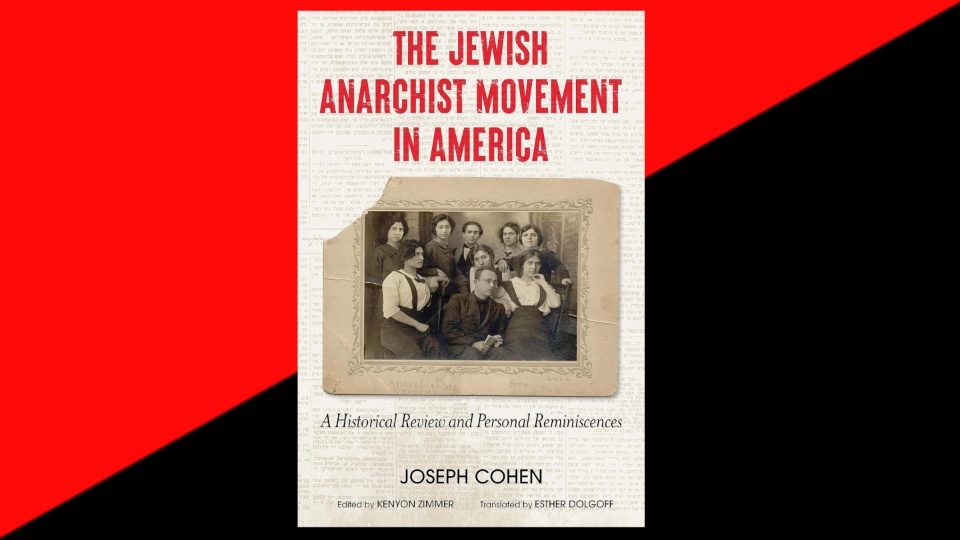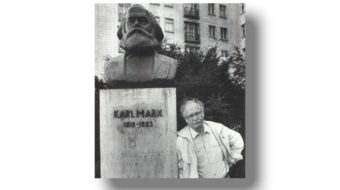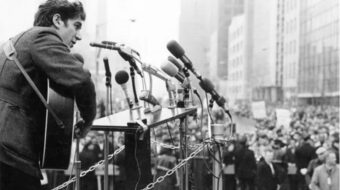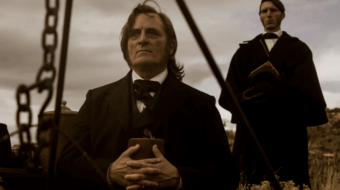
Joseph Cohen’s monumental work, subtitled “A Historical Review and Personal Reminiscences,” was published in Yiddish in Philadelphia in 1945. It has long been regarded as a seminal, if not definitive, source of detailed information and impressions on the topic of Jewish anarchism in America. Cohen was a participant, activist and observer, familiar with virtually every leading anarchist figure of his day, and many socialists and communists as well, who emerged out of the anarchist movement or were his contemporaries. This neglected history, available until now only to those who could read Yiddish, is now available to a much wider English readership.
Joseph Cohen (1878–1953) was a central figure of 20th-century American anarchism. He was born in Belarus and emigrated to the United States in 1903 with his wife, Sophie. They settled first in Philadelphia, where they raised two children. For 12 years, he edited the famed Yiddish paper, the Fraye arbeter shtime (Free Voice of Labor). Throughout his life he took part in various anarchist institutions such as the Radical Library, New York’s Francisco Ferrer Center, and the Stelton and Sunrise colonies. Cohen also wrote two other posthumously published books, The House Stood Forlorn (1954), a memoir of his childhood, and In Quest of Heaven: The Story of the Sunrise Co-operative Farm Community (1957), about the rise and fall of an anarchist commune.

Now that it is available, in a translation by Esther Dolgoff, who was a friend of Cohen, it can be considered essential reading in Jewish labor history, culture, and radicalism, intimately connected to other ethnic and labor institutions and communities. Jewish immigrants from Eastern Europe once comprised the largest segment of the anarchist movement in the United States. Part historical excavation and part memoir, Joseph Cohen chronicles events such as Alexander Berkman’s attack on Carnegie Steel executive Henry Clay Frick, the assassination of President William McKinley, the reaction to World War I, the Palmer Raids, key strikes in various industries, the arc of anarchist communes, schools and publications. He also turns his eye to behind-the-scenes conflicts among radicals, as well as profiles of famous personalities like Emma Goldman, Peter Kropotkin, Tom Mooney, Voltairine de Cleyre, Saul Yanovsky, Johann Most, and of the rank-and-file radicals who sustained the anarchist movement across North America from the 1880s to the 1940s.
Along the way, among all those he met and worked with, or sparred with, he identifies which factions of the left they came from, or where they wound up before and after their anarchist phase. As historians of the CPUSA well know, many future leaders started off as Wobblies or anarchists until the drifts of history led them in other directions.
The book also contains Cohen’s reflections on anarchist theory and tactics, based upon his experiences and observations. One great cataclysm after another brought out competing ideas, such as nationalism and patriotism, or even the defense of bourgeois democracy itself, that challenged classic anarchist doctrine. Should anarchists participate in war against Hitler, for example? In the light of the Holocaust, should anarchists embrace the new State of Israel? Should anarchists align with republicans, socialists and communists in the fight against Franco in Spain? Would anarchists testify against Reds in the McCarthy period? Many of these wrenching questions tore at the anarchist conscience.
No fool, in assessing the anarchist tradition to which he most devotedly belonged, Cohen nevertheless knew its weaknesses. He soberly addresses, for example, the common anarchist propensity to scorn reformism as they fixed their eyes on “the social revolution” that “was around the corner and would break out today or tomorrow all over the world”:

“But this theory did not fit with the facts of life. In their struggles, workers sought improvement, not complete liberation. They enthusiastically embraced anarchist agitation, regarding methods of struggle and applauded the lofty goals of anarchism without seriously examining how and when it could be achieved. Our movement took on a romantic character—great enthusiasm for lightning-fast, heroic acts without deep roots in the daily realities of life” (p. 167).
Joseph Cohen did not set out to pen a literary work of art, nor was he a trained historian. “Chronicler” might be the most accurate word for such a writer. As a result, the book he wrote needed a little polishing, correction of a few details, elimination of repetition, identifications of individuals (hundreds of them!) mentioned as activists in their day whose names would otherwise be lost to history. Edited and fully annotated, by Kenyon Zimmer, with every attention paid to standards of modern scholarship, this edition includes a wealth of supplementary information about the people, places, and events central to American anarchist history.
A piece of the chronicle that belongs to me
Zimmer is an Associate Professor of History at the University of Texas at Arlington, author of Immigrants Against the State: Yiddish and Italian Anarchism in America (2015) and co-editor of Wobblies of the World: A Global History of the IWW (2017), Deportation in the Americas: Histories of Exclusion and Resistance (2018), and With Freedom in Our Ears: Histories of Jewish Anarchism (2023). He had long been aware of Joseph Cohen’s tome, and possessed photocopies of Esther Dolgoff’s translation, so it was on his back burner to do something with it one day. The main problem, for years, was finding a publisher.
“Then, in December 2017,” Zimmer writes in his preface, “Eric A. Gordon contacted me after reading an article I had written [in The Volunteer] about American anarchists in the Spanish Civil War that also mentioned my book on Jewish and Italian anarchists. He wished to talk with me, he wrote, ‘about a project involving a translation from Yiddish to English of a book about the anarchist movement.’ Immediately I knew he could only mean the Dolgoff manuscript. Gordon, it turns out, was an erstwhile anarchist who had written a PhD dissertation about Brazilian anarchism and had been a friend of Esther and Sam Dolgoff back in the 1970s and 1980s. Shortly before her death in 1989, Gordon told me, Esther had entrusted the manuscript to him for possible publication. He and historian Paul Avrich saw to it that the text was transcribed into a word-processing file, but there the project stalled, again for lack of a publisher. Now Gordon, himself advanced in age and fearing that he would not be able to see the project through to completion, passed the torch to me.”

I should add that I did a certain amount of editing when I had it in digital form, and was able to forward that version to Kenyon. One of the editorial decisions I made early on, that Kenyon agreed with, was to render the names of newspapers and other words in Yiddish in a standardized, modern transliteration developed by YIVO, an almost century-old Jewish research institution specializing on the lives of Jews in Eastern Europe and their diaspora. Thus, Fraye arbeter shtime instead of the Germanic Freie Arbeiter Stimme.
There are no words for me to fully express my sense of contentment and satisfaction that this project that weighed so guiltily on my mind for decades has finally, in Kenyon Zimmer’s hands, reached fruition. One of the publishers I had approached myself was in fact AK Press, who turned me down. But Zimmer’s track record in the field of immigrant and anarchist studies, and his commitment to turning Cohen’s book into a real reference book far surpassing its original chronicle form, clearly persuaded that press to proceed with the project. As Sam and Esther Dolgoff’s son Anatole writes in his biographical sketch of his mother (1905-1989), “I know this: It is too bad Mother did not live to see her work, with her name on it, in print! To hold it in her hands! The satisfaction, the nakhes it would have brought her. Thank you, Kenyon, for this tribute to her memory”— nakhes being the glow of pride and joy such as when your kid graduates from medical school, or you publish your magnum opus. Anatole also wrote much about his mother in Left of the Left: My Memories of Sam Dolgoff, a biography of his father, that I reviewed in 2017 as “the kind of book any parent might wish their child to write: knowing and understanding, sympathetic but not idolizing, honest and intimate.”
“This monumental yet humble book,” says Cindy Barukh Milstein, editor of There Is Nothing So Whole as a Broken Heart, in her assessment, “offers the best of history-from-below. Better yet, it does so through a series of charming, page-turning reminiscences by a participant who lived and helped make this history, allowing us, in Cohen’s words, to ‘look back to the future’ as inspiration for our pursuit of the ‘grand ideal [of] complete liberation’ in the present. Thanks to Kenyon Zimmer’s meticulous edits and annotations, Cohen’s stories, at once so engagingly anarchist and so Jewish, come to life…. A true labor of love, The Jewish Anarchist Movement in America fills an enormous missing chapter of anarchist history and is a kaddish to honor the beautiful legacy of (our) Jewish anarchist ancestors.”
In perusing the Cohen-Zimmer book now in print, I found my eye drawn not so much to Cohen’s text, with which I was already well familiar in both English and Yiddish and didn’t need to reimmerse myself in, but down the page to the editor’s brief yet stunningly informative footnotes, recounting in a few words the lives and work of hundreds of individuals whose earthly existence the text alone only superficially names. Many of the details he uncovered derive from obituaries published in Cohen’s old newspaper, the Fraye arbeter shtime. One might grow dizzy flipping through the book and finding multiple such listings on virtually every page, but each one of them summons up a whole human life that in the vast majority of cases—though not all!—was lived in honor and dignity.

Here’s one that I casually stumbled into on p. 411 that surely fits into the “not all!” category:
“John G. Scott (1879-1953) was an American-born educator and onetime anarchist. A former member of the Socialist Party, around the First World War he began to describe himself as a ‘Thoreauvian anarchist.’ Scott taught at the anarchist Walt Whitman School in Los Angeles before being hired at the Stelton Modern School in 1915 and the Mohegan Modern School in 1926. In 1933-1934 he published the agrarian anarchist magazine Mother Earth with his then-companion Jo Ann Wheeler Burbank. Scott later became a Quaker and a member of the Christianity-based Social Credit movement before drifting into Christian nationalism and joining the fascist American Nationalist Party in 1945. He edited the journal Money (1936-1953), in which he republished the notorious antisemitic forgery The Protocols of the Elders of Zion.”
I don’t care to end on such an ugly note, so let’s move on to this one, also more or less randomly encountered on p. 489, which brings this couple closer to my own life: For 15 years (1995-2011) I served as Southern California Director of The Workers Circle (then Workmen’s Circle/Arbeter Ring), and I often heard from some of our senior members about the Kropotkin Literary Society and many other long-gone but dearly remembered local activists:
“Dora Keyser (Kayzer, 1899-1983) was a Russian-born Jewish garment worker and anarchist. The seventeenth of eighteen children, at the age of six she helped smuggle radical literature and witnessed pogroms during the revolution of 1905. Keyser immigrated to the United States in 1912 after the death of her father and joined the anarchist movement two years later, taking part in the Francisco Ferrer Center and the Zsherminal Group, as well as Local 22 of the ILGWU. She also married fellow Jewish anarchist Louis (Lyova) Keyser (c. 1895-1955), a member of the Union of Russian Workers. Around 1920 the couple moved to Philadelphia and joined the Radical Library, then relocated to the Stelton Colony in 1922 and the Sunrise Colony in 1934, before finally settling in Los Angeles in 1938. Both were active in the Kropotkin Literary Society, Branch 413 of the Workmen’s Circle, and in the 1970s and 1980s Dora worked on behalf of the United Farm Workers of America.”
Joseph Cohen, Esther Dolgoff, and Kenyon Zimmer: What a treasured legacy they have bequeathed us—to have rescued this book, and so many idealistic souls, from oblivion! Read it in good health!
Joseph Cohen
The Jewish Anarchist Movement in America: A Historical Review and Personal Reminiscences
Translated by Esther Dolgoff, edited by Kenyon Zimmer
Chico, Calif., and Edinburgh, Scotland: AK Press, 2024
Paperback, 600 pp., $32
ISBN-13: 9781849355483
We hope you appreciated this article. At People’s World, we believe news and information should be free and accessible to all, but we need your help. Our journalism is free of corporate influence and paywalls because we are totally reader-supported. Only you, our readers and supporters, make this possible. If you enjoy reading People’s World and the stories we bring you, please support our work by donating or becoming a monthly sustainer today. Thank you!










